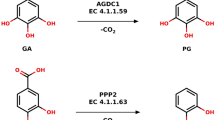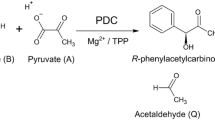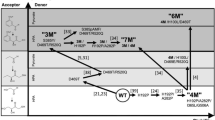Abstract
The mechanism by which the enzyme pyruvate decarboxylase from yeast is activated allosterically has been elucidated. A total of seven three-dimensional structures of the enzyme, of enzyme variants or of enzyme complexes form two yeast species (three of them reported here for the first time) provide detailed atomic resolution snapshots along the activation coordinate. The prime event is the covalent binding of the substrate pyruvate to the side chain of cysteine 221, thus forming a thiohemiketal. This reaction causes the shift of a neighbouring amino acid, which eventually leads to the rigidification of two otherwise flexible loops, where one of the loops provides two histidine residues necessary to complete the enzymatically competent active site architecture. The structural data are complemented and supported by kinetic investigations and binding studies and provide a consistent picture of the structural changes, which occur upon enzyme activation.
Similar content being viewed by others
Article PDF
Author information
Authors and Affiliations
Corresponding author
Rights and permissions
About this article
Cite this article
Kutter, S., Weiss, M., Wille, G. et al. Covalently bound substrate at the regulatory site triggers allosteric enzyme activation. Nat Prec (2008). https://doi.org/10.1038/npre.2008.1639.1
Received:
Accepted:
Published:
DOI: https://doi.org/10.1038/npre.2008.1639.1



